What is the Biggest Waterfall in the World? (The Answer May Surprise You!)
Think Victoria Falls is the biggest waterfall in the world? Think again. From towering drops to sheer volume, measuring the biggest waterfall depends on how you define it — and the real answer might surprise you. Here’s where the world’s biggest waterfall actually is, plus a few jaw-dropping contenders to add to your travel list.
Chasing Chanelle contains affiliate links and is a member of the Amazon Services LLC Associates Program. If you make a purchase using one of these links, we may receive compensation at no extra cost to you. We only recommend products and services we use and trust. Read our disclaimer for more information.
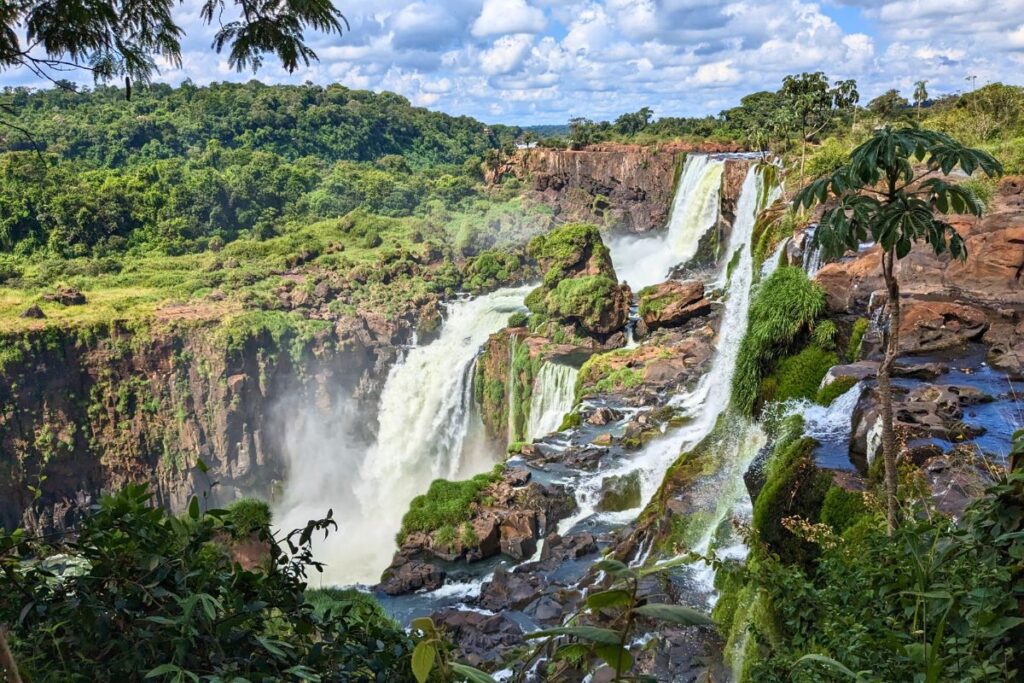
What is the Biggest Waterfall in the World?
This may come as a surprise, but technically speaking, the biggest waterfall in the world is actually underwater. Known as the Denmark Strait Cataract, it’s located between Greenland and Iceland, deep within the Denmark Strait.
This colossal underwater waterfall plunges an estimated 11,500 feet (3.5 kilometres) — more than three times the height of the tallest waterfall on land. Even more impressive, it carries a staggering 175 million cubic feet (nearly 5 million cubic meters) of water per second, creating one of the most powerful natural phenomena on Earth.
But unfortunately, you’ll never be able to see it. The Denmark Strait Cataract lies over 2,000 feet below the ocean’s surface, and visiting it would mean certain death — thanks to crushing water pressure, violent currents, and the sheer force of water tumbling through the deep.
So, what’s the biggest on-land waterfall in the world?
That depends on how you define “biggest.” Waterfalls vary widely in height, width, and volume, so there’s no single answer. Below, I’ve highlighted five of the largest and most spectacular waterfalls based on different criteria — and you can decide for yourself which one deserves the top spot.
5 of the World’s Biggest Waterfalls
While the Denmark Strait Cataract isn’t exactly visitor-friendly, the planet is home to plenty of massive waterfalls you can experience in person — each incredible in its own way.
From the tallest to the most powerful, I’ve pulled together five of the world’s biggest waterfalls by height, width, and flow rate. Not only are they massive, but they’re also some of the most awe-inspiring natural wonders on Earth.
How do I know? I’ve seen most of them myself! This list is based on a mix of research and firsthand experience — with just a couple still on my travel bucket list.
1. Victoria Falls
Located on the border between Zambia and Zimbabwe, Victoria Falls is the largest curtain of falling water in the world. It’s often considered the biggest waterfall overall and is recognized as one of the Seven Natural Wonders of the World.
Known locally as “Mosi-oa-Tunya”, meaning “The Smoke That Thunders”, these awe-inspiring falls stretch over 5,500 feet (1,700 meters) wide and drop 355 feet (108 meters) into the gorge below.
As the Zambezi River plunges into the Batoka Gorge, it creates a spectacular cascade of mist and spray — often illuminated by rainbows against the dramatic backdrop.
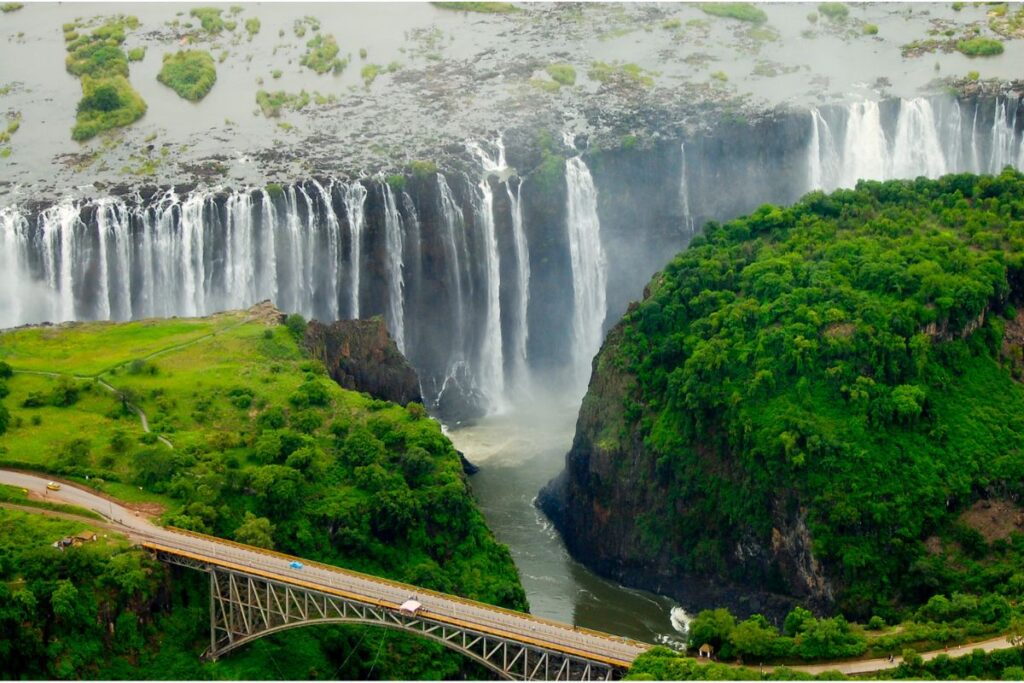
Victoria Falls is also one of Africa’s top tourist destinations, offering walking trails along the edge so you can take in the falls from a variety of stunning vantage points.
Plus, there are also tons of fun activities to do when visiting, including cruising down the Zambezi river, bungee jumping, swimming in Devil’s pool at the edge of the falls, flying over the falls, and white water rafting. And it’s a great place to visit to go on safari!
2. Iguazu Falls
Straddling the border between Brazil and Argentina, Iguazu Falls is the world’s largest collection of waterfalls and a designated Wonder of Nature — often seen as Victoria Falls’ biggest rival.
Having seen both, I’d say Iguazu Falls takes the lead in terms of beauty. What makes it so special is the vastness of the views — no other waterfall offers such a wide, cinematic panorama.
Made up of 275 individual cascades stretching across 1.6 miles (2.7 kilometres), the falls are surrounded by swirling mist, dramatic cliffs, and lush rainforest teeming with wildlife.
The landscape feels almost otherworldly — like something out of a fantasy movie.
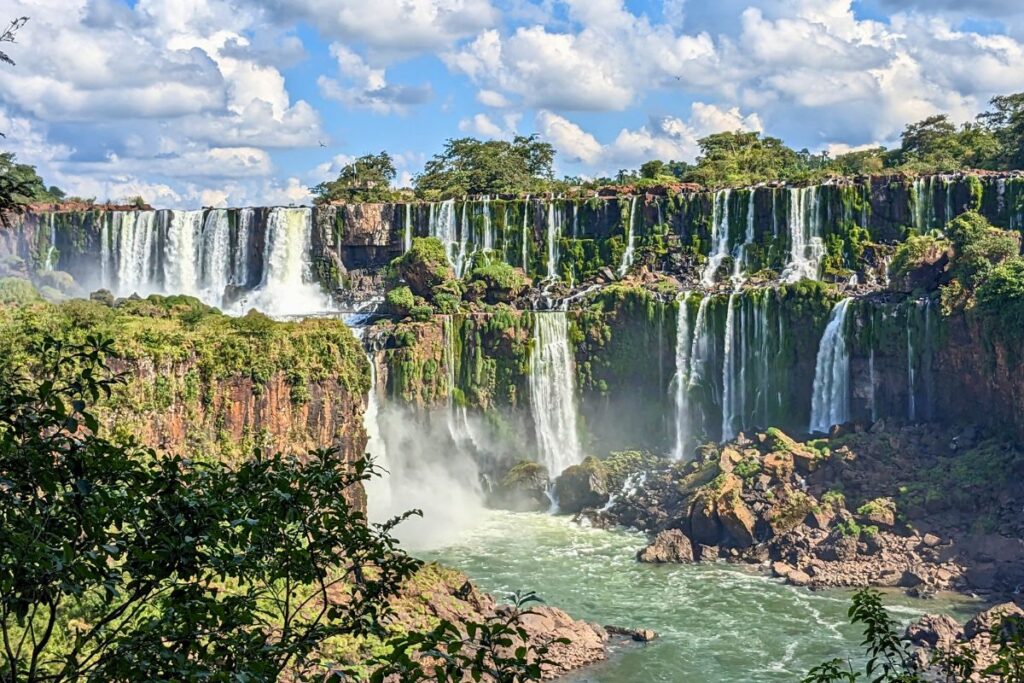
On the Argentinian side, you’ll find multiple hiking trails that let you take in the falls from a variety of up-close angles. On the Brazilian side, you’ll get a full panoramic view of 80% of the falls in one incredible frame.
You can also take a helicopter ride for a bird’s-eye view of the entire network, or hop on a boat down the Iguazu River to get as close as possible — even ducking under some of the smaller cascades for a thrilling (and soaking wet!) experience.
3. Angel Falls
Angel Falls in Venezuela is sometimes considered the biggest waterfall in the world due to its status as the tallest uninterrupted cascade of water on Earth.
Tucked away in Canaima National Park, this extraordinary waterfall plunges 3,212 feet (979 meters) over the edge of Auyán-Tepuí, a massive flat-topped mountain in the heart of the jungle.
Named after American aviator Jimmy Angel, who first flew over the falls in 1933, Angel Falls has become a powerful symbol of Venezuela’s natural beauty and a major (if remote) draw for adventurous travellers.
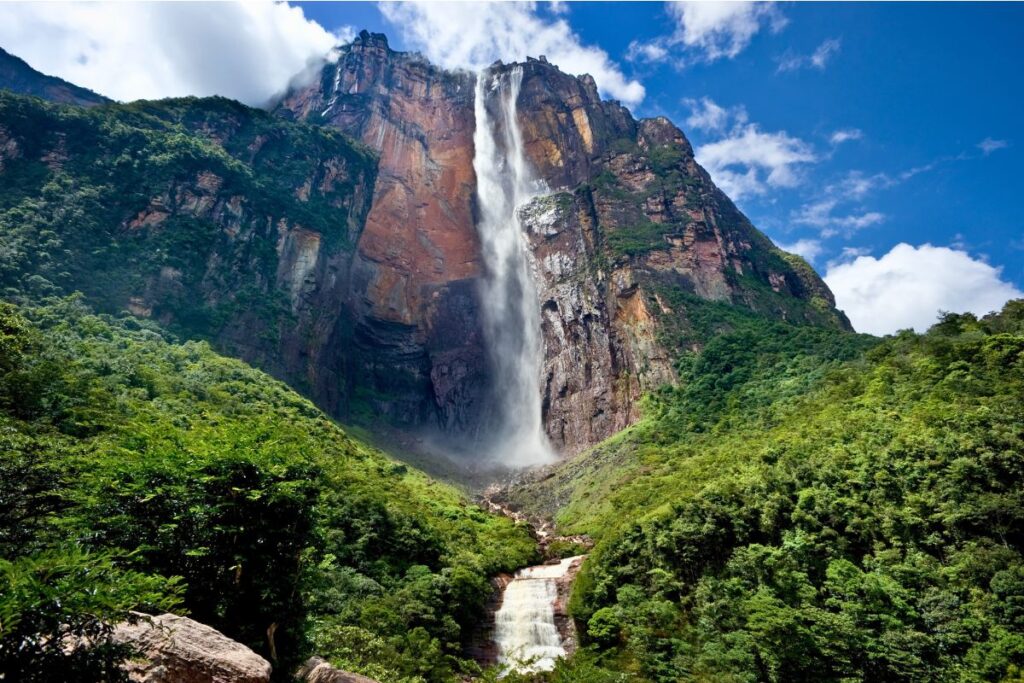
That said, travel to Venezuela is currently not recommended due to the country’s ongoing political and economic instability, as well as high levels of violent crime. Reaching Angel Falls is also no easy feat — Canaima National Park is accessible only by air, and visiting the falls typically requires a guided tour.
Most tours are 3 to 4 days long, departing from Santa Elena, Ciudad Bolívar, or the village of Canaima, and include transportation by boat or helicopter, meals, and lodging.
Note: Be sure to research thoroughly, understand the risks, and consult your country’s official travel advisories before deciding whether it’s safe to visit.
4. Niagara Falls
No list of massive waterfalls would be complete without Niagara Falls — the most famous waterfall in the world, shared by Canada and the United States.
While Niagara doesn’t come close to being the tallest or widest, it’s the largest waterfall in North America by volume — and arguably the most visually impressive, thanks to its sheer power.
During peak season, over 100,000 cubic feet (2,832 cubic metres) of water surge over the falls every second — that’s more than 5 million cubic feet per minute! Combined with its vast shape and constant roar, Niagara is a waterfall you feel as much as you see.

Niagara Falls is made up of three separate waterfalls: the American Falls, Bridal Veil Falls, and Horseshoe Falls (on the Canadian side).
The largest by far is Horseshoe Falls, which spans 2,200 feet (670 metres) and drops an average of 188 feet (57 metres). About 90% of the Niagara River flows over this section, making it the most dramatic part of the entire complex.
Located just 30 minutes from Buffalo or 1.5 hours from Toronto, Niagara Falls is by far the most accessible waterfall on this list. It also offers tons of activities, from boat rides to the base of the falls, to views from above at the Skylon Tower, and even walkways behind the falls for an up-close encounter.
5. Khone Falls
Although not as well known as the other waterfalls on this list, Khone Falls in Laos (also known as Khone Phapheng) holds the title of the widest waterfall in the world — and it’s another breathtaking force of nature.
Rather than a single drop, Khone Falls is a series of waterfalls and rapids along the Mekong River, flowing around a collection of small islands — some of which are inhabited.
While it’s not particularly tall, with a maximum drop of just 69 feet (21 metres), Khone Falls stretches an astonishing 35,376 feet (10.7 kilometres) across, making it the widest by far.
It’s also the largest waterfall by volume in Southeast Asia, and one of the most powerful in the world, with a flow rate of 410,000 cubic feet (11,600 cubic metres) per second — more than four times the volume of Niagara Falls!
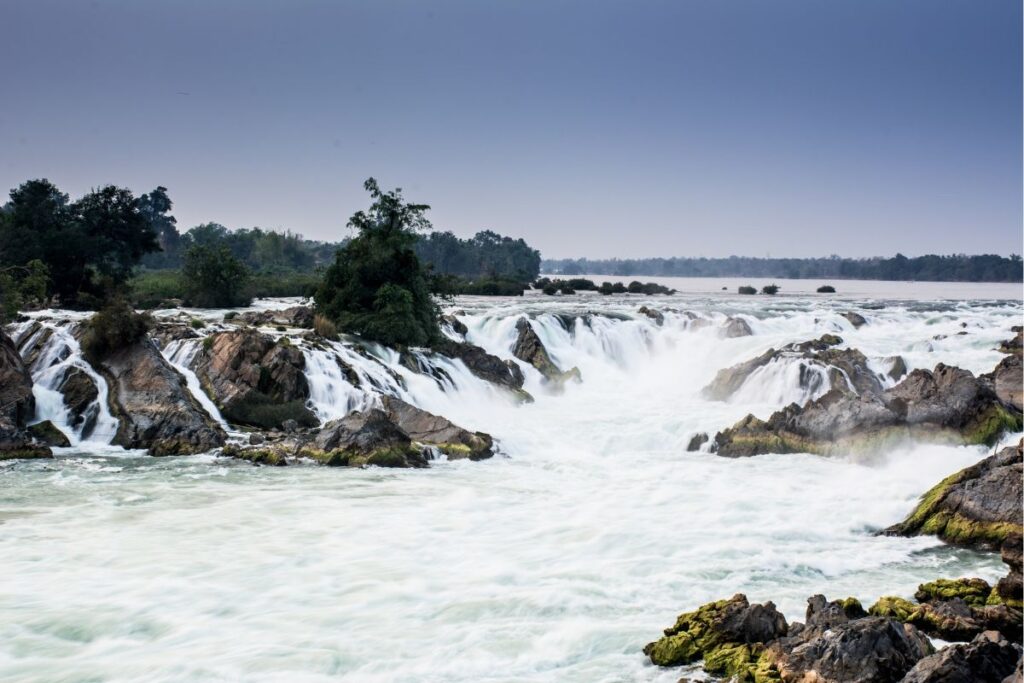
Khone Falls isn’t as easily accessible as other major waterfalls, but once you arrive, the area is well-equipped for visitors. To get there, head to Don Khon in the Si Phan Don (Four Thousand Islands) region of southern Laos. From there, you can join local tours and explore the surrounding waterfalls and islands.
FAQs
The Cascata delle Marmore, located in Umbria, Italy, is the largest man-made waterfall in the world. Built by the Romans in 271 BC, it stands 541 feet (165 metres) tall and was engineered to divert excess water from the Velino River into the Nera River below — creating a dramatic and still-active waterfall that remains a popular attraction today.
Niagara Falls is shared between both countries, but the majority of the water flows on the Canadian side. About 90% of the Niagara River flows over Horseshoe Falls, which is located in Ontario, Canada, while the smaller American Falls and Bridal Veil Falls are on the U.S. side in New York State.
No, Niagara Falls is not one of the official Seven Wonders of the World. However, it’s often considered one of the natural wonders of North America and is widely regarded as one of the most famous and iconic waterfalls in the world.
Niagara Falls is the biggest waterfall in the US by volume. In fact, it has the largest flow rate of any waterfall in North America!
The tallest waterfall in the U.S. is Yosemite Falls, located in Yosemite National Park, California. It drops a total of 2,425 feet (739 meters) from the top of the upper fall to the base of the lower fall, making it one of the tallest waterfalls in the world.
Inga Falls, located on the Congo River in the Democratic Republic of the Congo, has the highest flow rate of any waterfall in the world. However, it’s often debated whether it qualifies as a true waterfall, since it consists mostly of powerful rapids rather than a vertical drop.
Both Victoria Falls and Iguazu Falls are stunning natural wonders surrounded by lush, pristine landscapes — and each offers a unique experience. It’s hard to say which is better, as both are unforgettable in their own way.
Personally, I found Iguazu Falls slightly more impressive, simply because there’s more to explore and a wider variety of viewpoints. But it’s a close call — and if you have the chance, I highly recommend visiting both.
It depends on what you’re looking for, but Victoria Falls is generally considered the more impressive of the two. It’s much larger in size and offers a more immersive, natural setting — complete with wildlife and rainforest trails. Niagara Falls is still dramatic and powerful, but it’s smaller and more commercialized, with a strong city and tourism infrastructure around it.

Final Thoughts
It may come as a surprise, but the biggest waterfall in the world is actually hidden underwater. Still, there are plenty of enormous land-based waterfalls you can visit — and they’re truly awe-inspiring in their own right.
From the grandeur and natural beauty of Victoria Falls and Iguazu Falls to the raw power of Niagara’s Horseshoe Falls, the world is full of spectacular waterfalls waiting to be explored.
